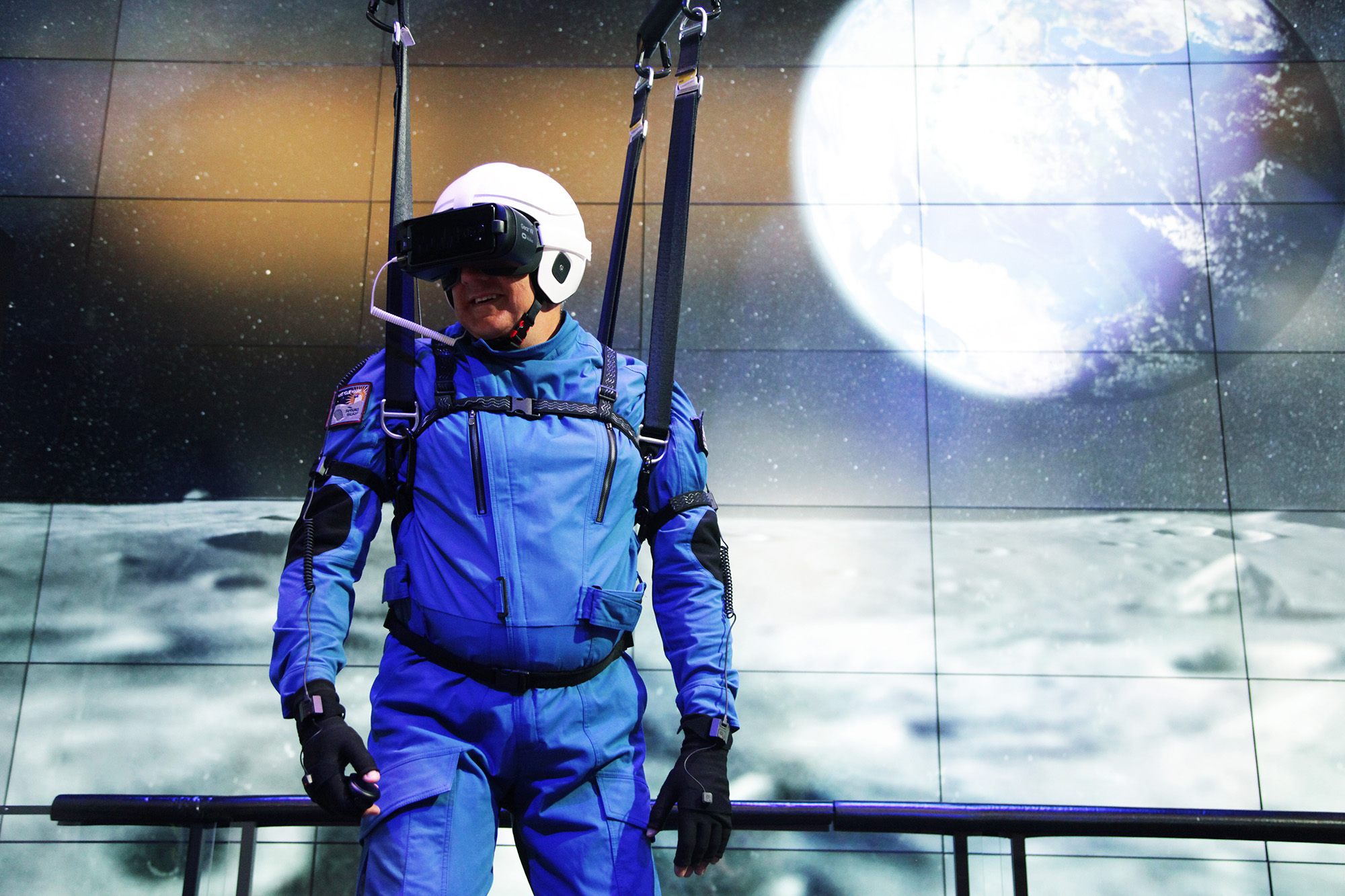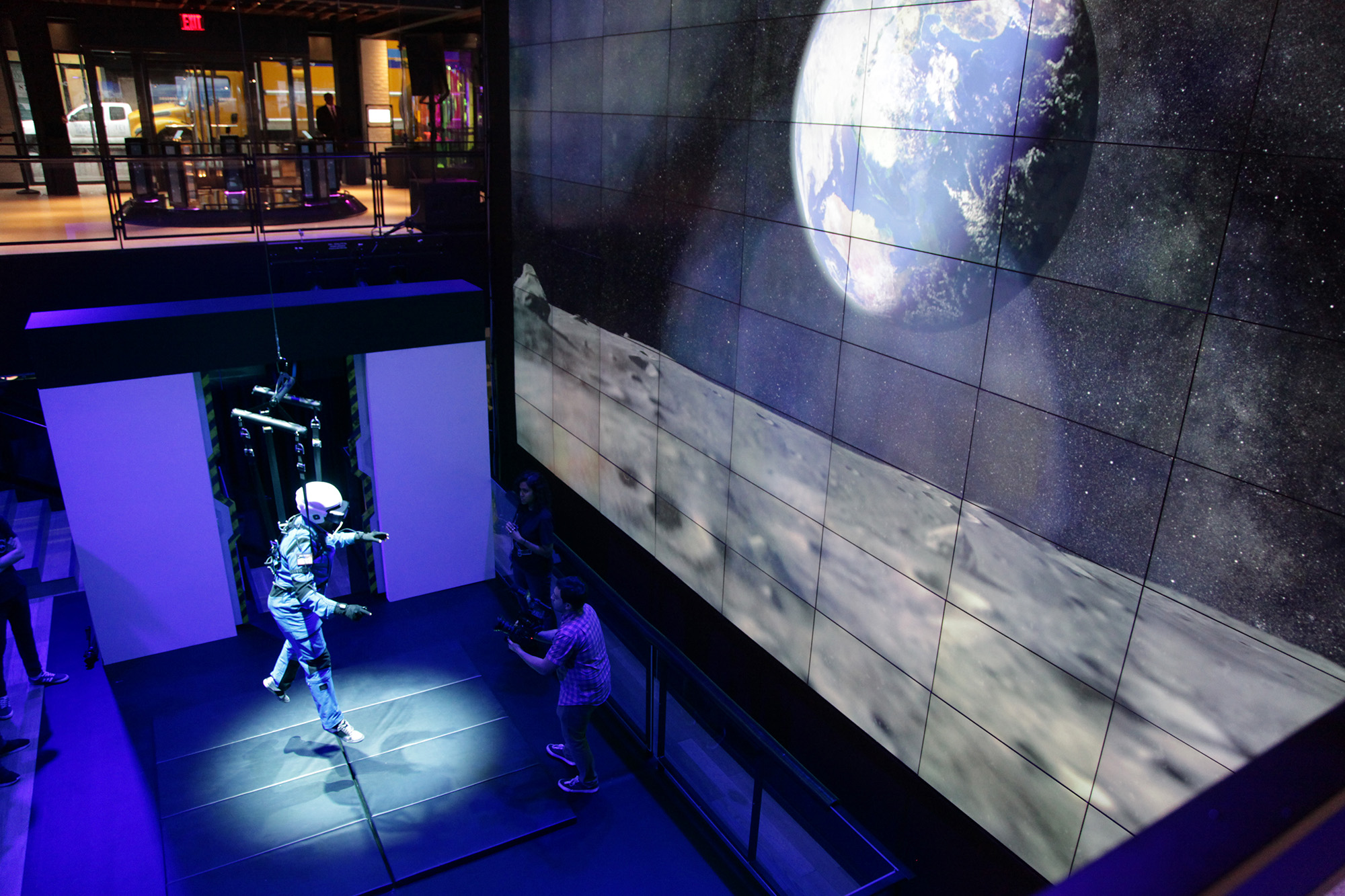Take a Virtual Walk on the Moon in New York City!
NEW YORK — Forty-nine years after Neil Armstrong took his first "small step" on the lunar surface, Samsung has brought his "giant leap for mankind" down to Earth by launching an out-of-this-world virtual-reality (VR) experience in New York City.
The experience, titled "A Moon for All Mankind," opened in the city's Meatpacking District today (July 19) — one day before the anniversary of the Apollo 11 moon landing — and will be open to the public for the next year in honor of the big 50th anniversary celebration in 2019.
To make the experience as realistic as possible, Samsung worked with NASA to not only create an accurate replica of the lunar landscape but also design flight suits and a "gravity offload rig" to help simulate the lower gravity on the moon, which is about one-sixth the gravity on Earth. That rig is modeled after NASA's Active Response Gravity Offload System, which astronauts use to simulate low- or zero-gravity environments during their training at NASA's Johnson Space Center in Houston. [Virtual Reality and Mars: 4 Ways Tech Will Change Space Exploration]
I gave the experience a whirl, and it was probably the most exciting VR space adventure I have experienced — and certainly the most disorienting. Rather than walking to move around on the moon, users are instructed to take small hops, moving only up and down. This aspect of the experience may seem unrealistic, because Apollo astronauts did more walking than jumping on the moon. However, walking around blindly with a VR headset while connected to the gravity offload rig seems extremely impractical.
After I stepped inside Samsung 837, a marketing center known as the "digital playground," Samsung's flight team showed me a video to brief me on my upcoming mission, and spacesuit technicians helped me into my harness, flight suit and VR helmet. The helmet uses the Samsung Gear VR, powered by Oculus and a Samsung Galaxy S9+ smartphone.
"The experience, the whole thing from start to finish — getting here, getting the briefing, getting dressed — is just like we would do for training events or for real spaceflight," NASA astronaut Mike Massimino, who also tried out the VR experience, said in a video Samsung officials recorded during his visit. "You need help to get your clothes on when you're going to space, and it was the same thing here."
All suited up and ready to go, I was taken to a padded floor in front of a huge screen and was hooked up to the gravity offload rig. Before I could begin my lunar adventure, the rig had to be calibrated to my body weight. Having lost about 130 lbs. (59 kilograms) to the rig and weighing about as much as an average 2-year-old, I was ready to take my first "giant leap" on the moon.
Breaking space news, the latest updates on rocket launches, skywatching events and more!
The mission wasn't easy. As I hopped around to follow a lunar rover to the edge of a huge crater, my flight control team kindly let me know that I was going all over the place and instructed me again to jump only straight up and down — which was easier said than done. While I may have felt like an astronaut inside my virtual environment, I suspect I looked more like a drunk person on one of those bungee trampolines you can find at beach resorts and amusement parks.
"There's a roomful of people watching you, but you sort of still feel that isolation, hear your heartbeat, hear the breathing," Massimino said. "You hear Capcom talking to you, and it's just you on the moonscape."
After flailing around and trying to get reacquainted with my own two legs for several minutes, I was struck with a newfound empathy for astronauts like moonwalker Harrison "Jack" Schmitt, who was caught on camera flopping around on the lunar surface during Apollo 17. Capcom Bob Parker referred to Schmitt as "twinkle toes" while he watched the video feed back on Earth.
The experience was more than just a physical feat. When you're on the virtual moon, the view is absolutely gorgeous, albeit entirely digital. Seeing Earth rise over the lunar horizon made me think of the famous Apollo 8 "Earthrise" photo. You can look up and around the see the sun, stars and constellations. It even includes a meteor shower!
Currently, "A Moon for All Mankind" is available to experience only at Samsung 837 in Manhattan. However, Samsung is working on a modified consumer version so that anyone with a VR headset and a smartphone can virtually explore the moon from home, Zach Overton, Samsung's vice president of consumer experience and general manager of Samsung 837, told Space.com. The company also plans to roll out new missions and features.
Overton said Samsung aims to use VR technology "to democratize experiences, events, cultural moments that are typically reserved for the elite few." While only 12 men have ever walked on the moon in real life, Overton said "we feel like it should be democratized; it should be something that everybody can experience."
Almost anyone can experience Samsung's virtual moon mission in New York. Guests must be at least 13 years old, in good health and not pregnant. To avoid lines at the door, you can sign up for a scheduled mission at 837GearVR.com.
Email Hanneke Weitering at hweitering@space.com or follow her @hannekescience. Follow us @Spacedotcom, Facebook and Google+. Original article on Space.com.

Hanneke Weitering is a multimedia journalist in the Pacific Northwest reporting on the future of aviation at FutureFlight.aero and Aviation International News and was previously the Editor for Spaceflight and Astronomy news here at Space.com. As an editor with over 10 years of experience in science journalism she has previously written for Scholastic Classroom Magazines, MedPage Today and The Joint Institute for Computational Sciences at Oak Ridge National Laboratory. After studying physics at the University of Tennessee in her hometown of Knoxville, she earned her graduate degree in Science, Health and Environmental Reporting (SHERP) from New York University. Hanneke joined the Space.com team in 2016 as a staff writer and producer, covering topics including spaceflight and astronomy. She currently lives in Seattle, home of the Space Needle, with her cat and two snakes. In her spare time, Hanneke enjoys exploring the Rocky Mountains, basking in nature and looking for dark skies to gaze at the cosmos.


